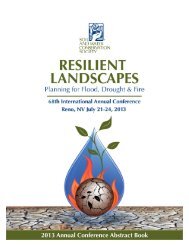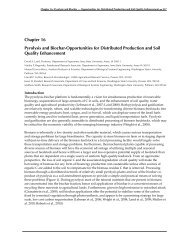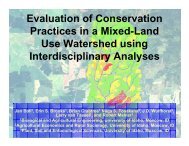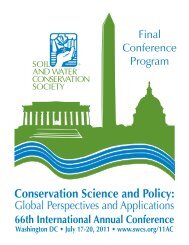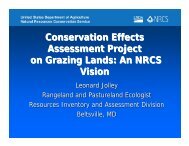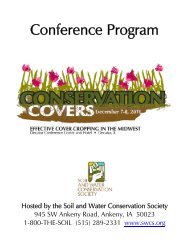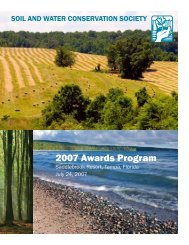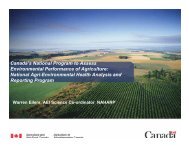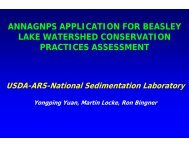Front Matter.indd - Soil and Water Conservation Society
Front Matter.indd - Soil and Water Conservation Society
Front Matter.indd - Soil and Water Conservation Society
You also want an ePaper? Increase the reach of your titles
YUMPU automatically turns print PDFs into web optimized ePapers that Google loves.
© SWCS. For Individual Use Only.
Environmental<br />
Benefits<br />
of <strong>Conservation</strong><br />
on Cropl<strong>and</strong><br />
The Status of<br />
Our Knowledge<br />
© SWCS. For Individual Use Only.
Environmental<br />
Benefits<br />
of <strong>Conservation</strong><br />
on Cropl<strong>and</strong><br />
The Status of<br />
Our Knowledge<br />
Max Schnepf <strong>and</strong> Craig Cox, Editors<br />
<strong>Soil</strong> <strong>and</strong> <strong>Water</strong> <strong>Conservation</strong> <strong>Society</strong><br />
Ankeny, Iowa<br />
© SWCS. For Individual Use Only.
Copyright @ 2006 by the <strong>Soil</strong> <strong>and</strong> <strong>Water</strong> <strong>Conservation</strong> <strong>Society</strong><br />
All rights reserved<br />
Manufactured in the United States of America<br />
Library of Congress Cataloging-in-Publication Data<br />
Environmental benefits of conservation practices on cropl<strong>and</strong> :<br />
the status of our knowledge / Max Schnepf <strong>and</strong> Craig Cox, editors.<br />
p. cm.<br />
Includes bibliographical references <strong>and</strong> index.<br />
ISBN-13: 978-0-9769432-3-5<br />
ISBN-10: 0-9769432-3-9<br />
1. Agricultural conservation--United States. 2. Agriculture <strong>and</strong> state--United States. 3. Agricultural l<strong>and</strong>scape<br />
management--United States. 4. Environmentalism--United States. I. Schnepf, Max, 1941- II. Cox, Craig A. (Craig Alan)<br />
S604.6.E58 2007<br />
630.973--dc22<br />
2007002199<br />
All photos are from the Photo Gallery, Natural Resources <strong>Conservation</strong> Service, U.S. Department of Agriculture.<br />
© SWCS. For Individual Use Only.
CONTENTS<br />
vi Contributors<br />
vii Foreword<br />
Craig Cox<br />
ix Preface<br />
Max Schnepf<br />
1<br />
1 <strong>Soil</strong> management practices<br />
R<strong>and</strong>all Reeder <strong>and</strong> Dale Westermann<br />
2<br />
89 <strong>Water</strong> management practices, rain-fed cropl<strong>and</strong><br />
J.L. Baker, M.J. Helmers, <strong>and</strong> J.M. Laflen<br />
3<br />
131 <strong>Water</strong> management practices, irrigated cropl<strong>and</strong><br />
Dean E. Eisenhauer, David Bjorneberg, <strong>and</strong> Dale Westermann<br />
4<br />
149 Nutrient management practices<br />
Andrew N. Sharpley, John P. Schmidt, <strong>and</strong> Gary W. Hergert<br />
5<br />
195 Pest management practices, pesticide mitigation<br />
R. Don Wauchope<br />
6<br />
243 Pest management practices, integrated pest management<br />
H. Michael Linker<br />
7<br />
269 L<strong>and</strong>scape management practices<br />
R. Lowrance, T.M. Isenhart, W.J. Gburek, F.D. Shields, Jr.,<br />
P.J. Wigington, Jr., <strong>and</strong> S.M. Dabney<br />
318 Index<br />
© SWCS. For Individual Use Only.
AUTHORS<br />
J.L. Baker<br />
Professor, Department of<br />
Agricultural <strong>and</strong> Biosystems<br />
Engineering, Iowa State<br />
University, Ames<br />
David Bjorneberg<br />
Agricultural Engineer,<br />
Northwest Irrigation <strong>and</strong><br />
<strong>Soil</strong> Research Laboratory,<br />
Agricultural Research<br />
Service, U.S. Department of<br />
Agriculture, Kimberly, Idaho<br />
S.M. Dabney<br />
Research Agronomist,<br />
National Sedimentation<br />
Laboratory, Agricultural<br />
Research Service, U.S.<br />
Department of Agriculture,<br />
Oxford, Mississippi<br />
Dean E. Eisenhauer<br />
Professor, Department of<br />
Agricultural <strong>and</strong> Biosystems<br />
Engineering, University of<br />
Nebraska, Lincoln<br />
W.J. Gburek<br />
Hydrologist, Pasture<br />
Systems <strong>and</strong> <strong>Water</strong>shed<br />
Management Research<br />
Unit, Agricultural Research<br />
Service, U.S. Department<br />
of Agriculture, University<br />
Park, Pennsylvania<br />
M.J. Helmers<br />
Assistant Professor, Department<br />
of Agricultural <strong>and</strong><br />
Biosystems Engineering,<br />
Iowa State University, Ames<br />
Gary W. Hergert<br />
Professor, Agronomy-Horticulture,<br />
Panh<strong>and</strong>le Research<br />
& Extension Center, University<br />
of Nebraska, Scottsbluff.<br />
T.M. Isenhart<br />
Associate Professor, Department<br />
of Natural Resources<br />
Ecology <strong>and</strong> Management,<br />
Iowa State University, Ames<br />
J.M. Laflen<br />
Professor, Department of<br />
Agricultural <strong>and</strong> Biosystems<br />
Engineering, Iowa State<br />
University, Ames<br />
H. Michael Linker<br />
Integrated Pest Management<br />
Coordinator, College of Agriculture<br />
<strong>and</strong> Life Sciences,<br />
<strong>and</strong> Professor, Crop Science<br />
<strong>and</strong> Entomology, North<br />
Carolina State University,<br />
Raleigh<br />
Richard Lowrance<br />
Ecologist, Southeast<br />
<strong>Water</strong>shed Research Unit,<br />
Agricultural Research<br />
Service, U.S. Department of<br />
Agriculture, Tifton, Georgia<br />
R<strong>and</strong>all Reeder<br />
Associate Professor, Department<br />
of Food, Agricultural<br />
<strong>and</strong> Biological Engineering,<br />
Ohio State University,<br />
Columbus<br />
Andrew N. Sharpley<br />
<strong>Soil</strong> Scientist, Pasture<br />
Systems <strong>and</strong> <strong>Water</strong>shed<br />
Management Research<br />
Unit, Agricultural Research<br />
Service, U.S. Department<br />
of Agriculture, University<br />
Park, Pennsylvania; now<br />
with Crop, <strong>Soil</strong> <strong>and</strong> Environmental<br />
Sciences, University<br />
of Arkansas, Fayetteville.<br />
John P. Schmidt<br />
<strong>Soil</strong> Scientist, Pasture<br />
Systems <strong>and</strong> <strong>Water</strong>shed<br />
Management Research<br />
Unit, Agricultural Research<br />
Service, U.S. Department<br />
of Agriculture, University<br />
Park, Pennsylvania<br />
F.D. Shields, Jr.<br />
Research Hydraulic Engineer,<br />
National Sedimentation<br />
Laboratory, Agricultural<br />
Research Service, U.S.<br />
Department of Agriculture,<br />
Oxford, Mississippi<br />
R. Don Wauchope<br />
Research Chemist <strong>and</strong><br />
Collaborator, Southeast<br />
<strong>Water</strong>shed Research Unit,<br />
Agricultural Research<br />
Service, U.S. Department of<br />
Agriculture, Tifton, Georgia<br />
Dale Westermann<br />
<strong>Soil</strong> Scientist, Northwest<br />
Irrigation <strong>and</strong> <strong>Soil</strong> Research<br />
Laboratory, Agricultural<br />
Research Service, U.S.<br />
Department of Agriculture,<br />
Kimberly, Idaho<br />
P.J. Wigington, Jr.<br />
Research Hydologist, U.S.<br />
Environmental Protection<br />
Agency, Corvallis, Oregon<br />
REVIEWERS<br />
<strong>Soil</strong> management<br />
Seth Dabney<br />
Agricultural Research<br />
Service, U.S. Department of<br />
Agriculture, Oxford, Mississippi<br />
Gyles R<strong>and</strong>all<br />
Department of <strong>Soil</strong>, <strong>Water</strong>,<br />
<strong>and</strong> Climate, University of<br />
Minnesota, Waseca<br />
Cathy Sebold<br />
Natural Resources <strong>Conservation</strong><br />
Service, U.S.<br />
Department of Agriculture,<br />
Lincoln, Nebraska<br />
Bruce Wight<br />
Natural Resources <strong>Conservation</strong><br />
Service, U.S.<br />
Department of Agriculture,<br />
Lincoln, Nebraska<br />
<strong>Water</strong> management<br />
Jerry Bernard<br />
Natural Resources <strong>Conservation</strong><br />
Service, U.S.<br />
Department of Agriculture,<br />
Washington, D.C.<br />
Mike Burkart<br />
Agricultural Research<br />
Service, U.S. Department of<br />
Agriculture, Ames, Iowa<br />
Brook Harker<br />
Agriculture <strong>and</strong> Agri-Food<br />
Canada, Regina, Saskatchewan<br />
Eilenn Kladivko<br />
Department of Agronomy,<br />
Purdue University, West<br />
Lafayette, Indiana<br />
Jerry Lemunyon<br />
Natural Resources <strong>Conservation</strong><br />
Service, U.S. Department<br />
of Agriculture, Fort<br />
Worth, Texas<br />
Nurient<br />
management<br />
Dennis Francis<br />
Agricultural Research<br />
Service, U.S. Department<br />
of Agriculture, Lincoln,<br />
Nebraska<br />
Bill Kuenstler<br />
Natural Resources <strong>Conservation</strong><br />
Service, U.S. Department<br />
of Agriculture, Fort<br />
Worth, Texas<br />
Antonio Mallarino<br />
Department of Agronomy<br />
Iowa State University, Ames<br />
Dwayne Westfall<br />
<strong>Soil</strong> <strong>and</strong> Crop Sciences<br />
Department, Colorado State<br />
University, Fort Collins<br />
Pest management<br />
David Eckhardt<br />
U.S. Geological Survey,<br />
Ithaca, New York<br />
Cathleen Hapeman<br />
Agricultural Research<br />
Service, U.S. Department<br />
of Agriculture, Beltsville,<br />
Maryl<strong>and</strong><br />
L<strong>and</strong>scape<br />
management<br />
Tom Drewes<br />
Natural Resources <strong>Conservation</strong><br />
Service, U.S.<br />
Department of Agriculture,<br />
Beltsville, Maryl<strong>and</strong><br />
Peter Groffman<br />
Institute of Ecosystem Studies,<br />
Millbrook, New York<br />
Lyn Townsend<br />
Natural Resources <strong>Conservation</strong><br />
Service, U.S.<br />
Department of Agriculture,<br />
Portl<strong>and</strong>, Oregon<br />
Mark Weltz<br />
Agricultural Research<br />
Service, U.S. Department<br />
of Agriculture, Beltsville,<br />
Maryl<strong>and</strong><br />
© SWCS. For Individual Use Only.<br />
vi
FOREWORD<br />
This book is a product of two important changes<br />
in U.S. agricultural conservation policy: (1) the<br />
advent of the environmental movement <strong>and</strong> (2)<br />
major increases in funding for U.S. Department<br />
of Agriculture (USDA) conservation programs.<br />
For decades, the primary purpose of agricultural<br />
conservation programs was to improve the<br />
productivity of U.S. farms <strong>and</strong> ranches <strong>and</strong> to<br />
protect the “natural resource base” that sustained<br />
the agricultural enterprise. In the past 15<br />
years the environmental agenda—water quality,<br />
air quality, biodiversity, among other objectives—has<br />
superseded traditional objectives as<br />
the primary purposes of agricultural conservation<br />
programs. This change in goals, in my view, is<br />
the most important development in U.S. agricultural<br />
conservation programs since their inception<br />
in the 1930s.<br />
This change in purpose has been accompanied<br />
by a very large increase in funding for<br />
U.S. Department of Agriculture conservation<br />
programs <strong>and</strong> a new emphasis on improving the<br />
environmental management of working farms <strong>and</strong><br />
ranches. Departmental conservation programs now<br />
account for expenditures of more than $4.5 billion<br />
a year, nearly double what was spent annually<br />
for those programs prior to the 2002 farm bill.<br />
Dem<strong>and</strong>s to document what taxpayers’ are getting<br />
for their investment in conservation have increased<br />
h<strong>and</strong>-in-h<strong>and</strong> with the increase in funding.<br />
These two policy changes create an urgent<br />
need to retool conservation practices, programs,<br />
<strong>and</strong> policy to meet the environmental challenge<br />
<strong>and</strong> to improve our ability to quantify, or at least<br />
simulate, the effect conservation practices <strong>and</strong><br />
programs are having on environmental outcomes.<br />
Both of these needs can only be met by retooling<br />
<strong>and</strong> building our science base to inform environmental<br />
management in agricultural l<strong>and</strong>scapes.<br />
This book is intended to be a first step toward<br />
retooling <strong>and</strong> building that science base by documenting<br />
what we know <strong>and</strong> what we don’t know<br />
about the effect current conservation practices<br />
applied to cropl<strong>and</strong> have on the environment. Our<br />
goal was to consolidate current scientific knowledge<br />
to (1) immediately enhance the effectiveness<br />
of conservation programs <strong>and</strong> (2) make strategic<br />
decisions about strengthening our science base in<br />
the future.<br />
Our task proved more difficult than anticipated,<br />
but also more rewarding. After reading<br />
these chapters, I am left with a greater sense<br />
of optimism that we can achieve our ultimate<br />
objective—enhancing productivity, sustaining our<br />
resource base, <strong>and</strong> improving the environment<br />
simultaneously.<br />
Clearly, we know much more than we are using<br />
on a day-to-day basis to improve environmental<br />
quality in agricultural l<strong>and</strong>scapes. We could<br />
increase immediately the effectiveness of our<br />
efforts by wider <strong>and</strong> sustained application of the<br />
knowledge of practice effects <strong>and</strong> interactions<br />
contained between the covers of this book. A<br />
more intensive effort to translate science into<br />
practice would pay large dividends for taxpayers,<br />
agriculture, <strong>and</strong> the environment. The benefit, for<br />
example, of more precise targeting of conservation<br />
practices emerges in these pages as perhaps<br />
the biggest short-term opportunity to increase the<br />
effectiveness of our efforts. Where conservation<br />
practices are placed on the l<strong>and</strong>scape appears to<br />
be as important to determining environmental<br />
effects as which specific practices are applied.<br />
Translating what we currently know into more<br />
effective tools for targeting effort <strong>and</strong> investing<br />
more in research <strong>and</strong> development to produce <strong>and</strong><br />
deploy more effective tools should, I think, be a<br />
high priority for policymakers, research leaders,<br />
<strong>and</strong> program managers.<br />
Finally, it is clear that we have in h<strong>and</strong> conservation<br />
practices <strong>and</strong> systems that, if applied<br />
effectively, produce real <strong>and</strong> meaningful environmental<br />
benefits. Those practices <strong>and</strong> systems are<br />
the “low-hanging fruit” that, if harvested, would<br />
accelerate production of the environmental benefits<br />
agriculture needs <strong>and</strong> taxpayers want.<br />
There are many more reasons for optimism<br />
contained in this book—too many to list here.<br />
But there also is ample evidence of the magnitude<br />
of the challenge we face <strong>and</strong> the imperative<br />
of making strategic investments now to improve<br />
our ability to meet that challenge. I hope this<br />
book helps to improve conservation science,<br />
practice, programs, <strong>and</strong> policies. Most importantly,<br />
I hope this book is just the beginning—a<br />
helpful contribution to a strategic, coordinated,<br />
<strong>and</strong> effective effort to meet the environmental<br />
challenge confronting our nation’s agriculture.<br />
— Craig Cox<br />
This book<br />
is intended<br />
to be a first<br />
step toward<br />
retooling <strong>and</strong><br />
building that<br />
science base<br />
by documenting<br />
what<br />
we know<br />
<strong>and</strong> what we<br />
don’t know<br />
about the<br />
effect current<br />
conservation<br />
practices<br />
applied to<br />
cropl<strong>and</strong><br />
have on the<br />
environment.<br />
© SWCS. For Individual Use Only.<br />
vii
PREFACE<br />
In 2004, as an adjunct to the <strong>Conservation</strong> Effects<br />
Assessment Project (CEAP), U.S. Department<br />
of Agriculture officials asked the staff of the<br />
<strong>Soil</strong> <strong>and</strong> <strong>Water</strong> <strong>Conservation</strong> <strong>Society</strong> to undertake<br />
a comprehensive literature review as a means of<br />
documenting the environmental effects of incorporating<br />
conservation practices into agricultural<br />
operations. The prime objective of this effort<br />
was to construct a scientific foundation for the<br />
CEAP initiative by documenting what we know<br />
<strong>and</strong> don’t know about the environmental effects<br />
of putting conservation practices on the l<strong>and</strong>.<br />
Through CEAP, departmental officials hope to<br />
quantify the environmental benefits of conservation<br />
efforts more rigorously than in the past.<br />
The first phase of the work by <strong>Society</strong> staff was<br />
to focus on what effects conservation practices<br />
applied to cropl<strong>and</strong> might have with regard to<br />
four environmental outcomes: water quality, soil<br />
quality, water conservation, <strong>and</strong> air quality. The<br />
Wildlife <strong>Society</strong> simultaneously undertook an<br />
assessment of cropl<strong>and</strong> conservation practice<br />
effects on fish <strong>and</strong> wildlife habitat. Subsequent<br />
assessments were to look at practice effects on<br />
grazing l<strong>and</strong>, wetl<strong>and</strong>s, <strong>and</strong> other l<strong>and</strong> uses.<br />
A decision was made to divide the assessent<br />
into five basic conservation systems—soil management,<br />
water management, nutrient management,<br />
pest management, <strong>and</strong> l<strong>and</strong>scape management—then<br />
subdivide each of those conservation<br />
systems into two basic cropping systems—rainfed<br />
cropl<strong>and</strong> <strong>and</strong> irrigated cropl<strong>and</strong>.<br />
A lead author was then selected for each chapter—based<br />
on the demonstrated capability <strong>and</strong><br />
expertise of that individual to deal with the assigned<br />
subject matter. Each lead author was given<br />
the discretion to recruit co-authors.<br />
Authors were asked to undertake a comprehensive<br />
literature search <strong>and</strong> summarize, in an<br />
integrated fashion, what is know <strong>and</strong> not known<br />
about the following five elements:<br />
• Positive <strong>and</strong>/or negative environmental<br />
effects on water quality, soil quality, water<br />
conservation, <strong>and</strong> air quality, in that order.<br />
• Interactions <strong>and</strong> potential tradeoffs among<br />
conservation practices, systems, <strong>and</strong> environmental<br />
outcomes.<br />
• Key factors driving the magnitude <strong>and</strong> direction<br />
of environmental effects, interactions, <strong>and</strong><br />
tradeoffs.<br />
• The degree of confidence that could be accorded<br />
the documented environmental effects.<br />
• Critical gaps in knowledge that called for<br />
additional research.<br />
To achieve some consistency among chapters,<br />
authors were given a st<strong>and</strong>ardized outline to follow.<br />
A workshop, held in January 2005 to review <strong>and</strong><br />
critique initial drafts of chapters, involved authors<br />
<strong>and</strong> peer reviewers (who also reviewed subsequent<br />
manuscript drafts). At that workshop, participants<br />
opted to forego the rain-fed versus irrigated<br />
cropping system division except in the case of the<br />
chapters on water management practices. Their<br />
rationale was simply that too much duplication<br />
would be introduced into the various chapters if<br />
the division were retained. A later decision to split<br />
the pest management practices chapter into two<br />
chapters—pesticide mitigation <strong>and</strong> integrated pest<br />
management—was based on unrelated factors,<br />
including a change in authors.<br />
Workshop participants also agreed on a “division<br />
of labor” among the chapters with respect<br />
to the conservation practices covered (see list on<br />
page x). All conservation practices commonly<br />
applied to cropl<strong>and</strong> <strong>and</strong> for which the Natural<br />
Resources <strong>Conservation</strong> Service had established<br />
a national st<strong>and</strong>ard were divided among the<br />
five subject areas—soil management practices,<br />
water management practices, nutrient management<br />
practices, pest management practices, <strong>and</strong><br />
l<strong>and</strong>scape management practices. A few practices<br />
were placed in multiple chapters because authors<br />
felt compelled to cover those practices to achieve<br />
the degree of comprehensiveness requested.<br />
Authors also were allowed to add to the list<br />
practices for which no national st<strong>and</strong>ard exists to<br />
accommodate innovation <strong>and</strong> new technologies.<br />
The project proved to be a real challenge for<br />
authors, reviewers, <strong>and</strong> editors. Literature searches<br />
proved especially difficult, in part because of<br />
the volume of published information available on<br />
certain conservation practices <strong>and</strong> in part because<br />
of the lack of published research on other practices.<br />
Also difficult was the location of so-called<br />
“gray” literature—those extension bulletins, technical<br />
notes, <strong>and</strong> other materials regularly issued<br />
by agencies <strong>and</strong> academic institutions. In the end,<br />
much of that material was ignored.<br />
So, for what it is worth, here is the final product<br />
of this ambitious undertaking. Shortcomings<br />
likely are obvious. At the same time, project<br />
participants pulled together an enormous amount<br />
of material relating to the environmental effects<br />
of putting conservation practices on cropl<strong>and</strong>,<br />
material that should prove useful to conservation<br />
policymakers <strong>and</strong> practitioners alike.<br />
<strong>Society</strong> staff members thank the authors <strong>and</strong><br />
reviewers for their significant contributions to<br />
this effort. Thanks also are due officials of the<br />
U.S. Department of Agriculture’s Agricultural<br />
Research Service <strong>and</strong> Natural Resources <strong>Conservation</strong><br />
Service who supported the effort financially<br />
<strong>and</strong> otherwise.<br />
— Max Schnepf<br />
© SWCS. For Individual Use Only.<br />
ix
CROPLAND CONSERVATION PRACTICES<br />
During a workshop held as part of this literature review project, authors <strong>and</strong> peer reviewers created a list of all cropl<strong>and</strong>-oriented conservation<br />
practices for which Natural Resources <strong>Conservation</strong> Service personnel had set national st<strong>and</strong>ards. Those practices were then divided among the<br />
five general topics dealt with in this book. A h<strong>and</strong>ful of additional conservation practices or activities for which no national st<strong>and</strong>ards exist were<br />
then added to the list, which follows. Generally, authors attempted to avoid duplicate coverage of a specific practice from one chapter to another,<br />
but that was not always possible.<br />
<strong>Soil</strong> management practices<br />
Alley cropping 311<br />
<strong>Conservation</strong> cover 327<br />
<strong>Conservation</strong> crop rotation 328<br />
Contour buffer strip 332<br />
Contour farming 330<br />
Contour orchard 331<br />
Cover crop 340<br />
Critical area planting 342<br />
Cross-wind ridges<br />
589A<br />
Cross-wind trap strips<br />
589C<br />
Deep tillage 324<br />
Field border 386<br />
Herbaceous wind barrier 603<br />
Mulching 484<br />
PAM 450<br />
Residue management, mulch till<br />
329B<br />
Residue management, no till/strip till<br />
329A<br />
Residue management, ridge till<br />
329C<br />
Residue management, seasonal 344<br />
Salinity <strong>and</strong> sodic soil management 610<br />
Stripcropping 585<br />
Surface roughening 609<br />
Tree/shrub establishment 612<br />
Vegetative barrier 601<br />
Windbreak/shelterbelt establishment 380<br />
Windbreak/shelterbelt renovation 650<br />
<strong>Water</strong> management practices<br />
Ditch vegetation<br />
Diversion 362<br />
Drainage water management 554<br />
Filter strip 393<br />
Grade stabilization structure 410<br />
Grassed waterway 412<br />
Hillside ditch 423<br />
Irrigation canal/lateral 320<br />
Irrigation ditch/canal lining, plain concrete<br />
428A<br />
Irrigation ditch/canal lining, flexible membrane<br />
428B<br />
Irrigation ditch/canal lining, galvanized steel<br />
428C<br />
Irrigation field ditch 388<br />
Irrigation l<strong>and</strong> leveling 464<br />
Irrigation regulating reservoir 552<br />
Irrigation storage reservoir 436<br />
Irrigation system, microirrigation 441<br />
Irrigation system, sprinkler 442<br />
Irrigation system, surface/subsurface 443<br />
Irrigation system, tailwater recovery 447<br />
Irrigation pipeline, aluminum tubing<br />
430AA<br />
Irrigation pipeline, asbestos-cement<br />
430BB<br />
Irrigation pipeline, nonreinforced concrete<br />
430CC<br />
Irrigation pipeline, high-pressure,<br />
underground, plastic<br />
430DD<br />
Irrigation pipeline, low-pressure,<br />
underground, plastic<br />
430EE<br />
Irrigation pipeline, steel<br />
430FF<br />
Irrigation pipeline, reinforced plastic mortar<br />
430GG<br />
Irrigation pipeline, rigid gated pipeline<br />
430HH<br />
Irrigation water management 449<br />
Mole drain 482<br />
Open channel 582<br />
Precision l<strong>and</strong> forming 462<br />
Pumping plant 533<br />
Riparian forest buffer 391<br />
Riparian herbaceous cover 390<br />
Rock barrier 555<br />
Row arrangement 557<br />
Structure for water control 587<br />
Subsurface drainage 606<br />
Surface drainage, field ditch 607<br />
Surface drainage, main/lateral 608<br />
Terrace 600<br />
Tile line drainage innovations<br />
Underground outlet 620<br />
Vertical drain 630<br />
<strong>Water</strong> <strong>and</strong> sediment control basin 638<br />
<strong>Water</strong>spreading 640<br />
<strong>Water</strong> well 642<br />
Well decommissioning 351<br />
Nutrient management practices<br />
Anaerobic digester, ambient temperature 365<br />
Anaerobic digester, controlled temperature 366<br />
Atmospheric resources quality management 370<br />
<strong>Conservation</strong> crop rotation 328<br />
Composting facility 317<br />
Cover crop 340<br />
Feed management 592<br />
Manure transfer 634<br />
Nutrient management 590<br />
Roof-runoff structure 558<br />
Waste treatment lagoon 359<br />
Waste storage 313<br />
Waste utilization 633<br />
Wastewater treatment strip 635<br />
Well-water testing 355<br />
Pest management practices<br />
Atmospheric resources<br />
quality management 370<br />
<strong>Conservation</strong> cover 327<br />
<strong>Conservation</strong> crop rotation 328<br />
Cover crop 340<br />
Mulching 484<br />
Pest management 595<br />
L<strong>and</strong>scape management practices<br />
Corridor connectivity<br />
Channel bank vegetation 322<br />
Channel stabilization 584<br />
Dam 402<br />
Early succession habitat<br />
development/management 647<br />
Green-tree reservoir<br />
Impoundment<br />
Perennial vegetation re-establishment<br />
Pond 378<br />
Restoration/management of<br />
declining habitats 643<br />
Riparian forest buffer 391<br />
Riparian herbaceous cover 390<br />
Stream habitat<br />
improvement/management 395<br />
Streambank-shoreline protection 580<br />
Structure for water control 587<br />
Upl<strong>and</strong> wildlife habitat management 645<br />
<strong>Water</strong> <strong>and</strong> sediment basin 638<br />
Wetl<strong>and</strong> creation 658<br />
Wetl<strong>and</strong> enhancement 659<br />
Wetl<strong>and</strong> restoration 657<br />
Wetl<strong>and</strong> wildlife habitat improvement 644<br />
Windbreak/shelterbelt establishment 380<br />
© SWCS. For Individual Use Only.<br />
x



